2018 MERCEDES-BENZ CLA tire size
[x] Cancel search: tire sizePage 21 of 326
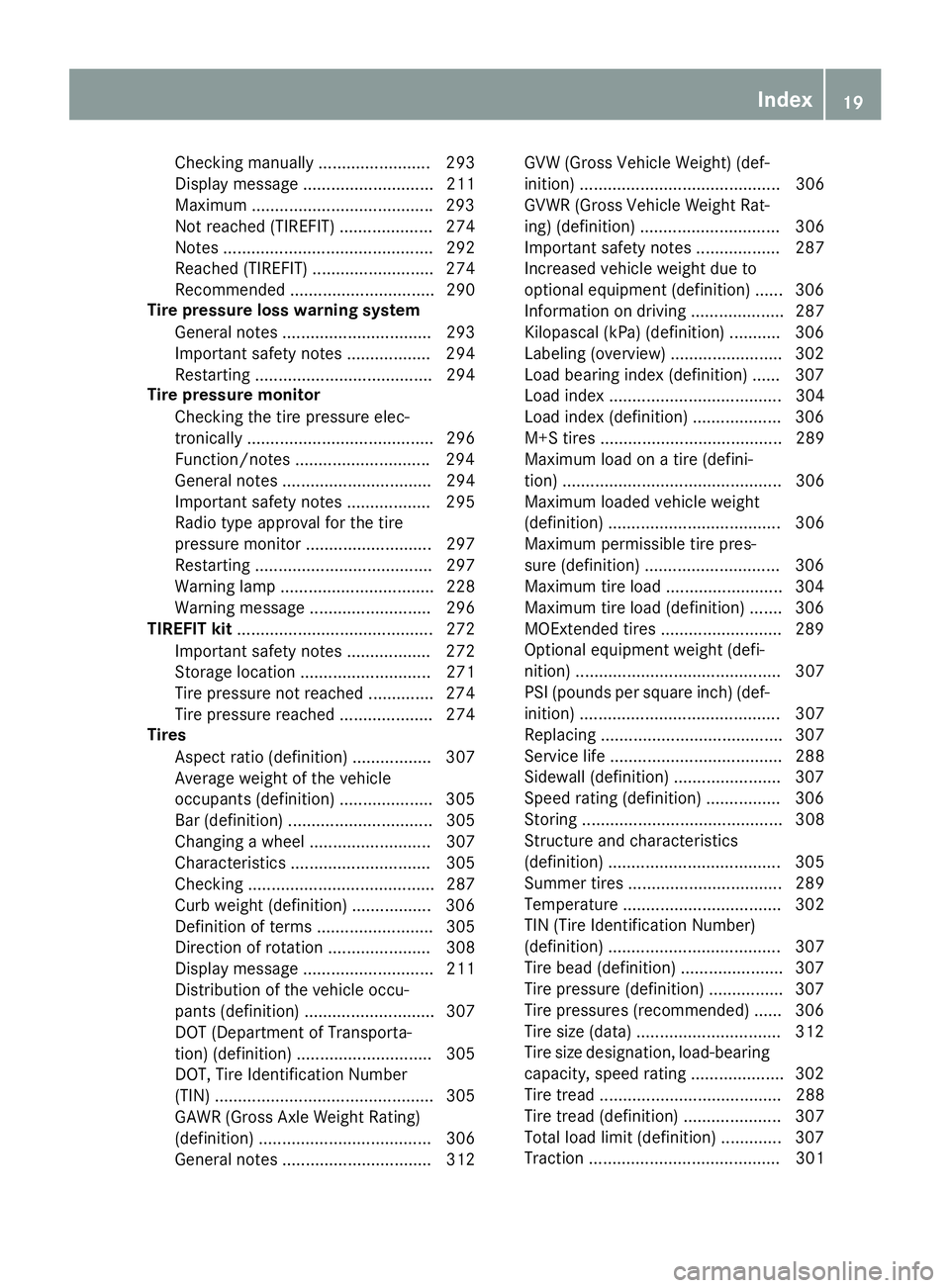
Checkin gm anually ........................ 293
Dis play message ............................ 211
Maximum ...................................... .2 93
Not reached (TIREFIT) .................... 274
Notes ............................................. 292
Reached (TIREFIT) .......................... 274
Recommended ............................... 290
Tire pressure los sw arning system
General notes ................................ 293
Important safety notes .................. 294
Restarting ...................................... 294
Tire pressure monitor
Checking the tire pressure elec-
tronically ........................................ 296
Function/notes ............................ .2 94
General notes ................................ 294
Important safety notes .................. 295
Radio type approval for the tire
pressure monitor ........................... 297
Restarting ...................................... 297
Warning lamp ................................. 228
Warning message .......................... 296
TIREFIT kit .......................................... 272
Important safety notes .................. 272
Storage location ............................ 271
Tire pressure not reached .............. 274
Tire pressure reached .................... 274
Tires
Aspect ratio (definition) ................. 307
Averag ew eight of the vehicle
occupants (definition) .................... 305
Bar (definition) ............................... 305
Changing aw heel .......................... 307
Characteristics .............................. 305
Checking ........................................ 287
Curb weight (definition) ................. 306
Definition of terms ......................... 305
Direction of rotatio n. ..................... 308
Displa ym essage ............................ 211
Distribution of the vehicl eo ccu-
pants (definition) ............................ 307
DOT (Department of Transporta-
tion) (definition) ............................. 305
DOT, T ire Identification Number
(
TIN) ............................................... 305
GAW R( Gr os sA xle Weight Rating)
(definition) ..................................... 306
Genera ln otes ................................ 312 GV W( Gr os sV ehicl eW eight) (def-
inition) ........................................... 306
GVWR (Gros sV ehicl eW eight Rat-
ing )( de finition) .............................. 306
Important safety notes .................. 287
Increased vehicl ew eigh td ue to
optiona le quipment (definition) ...... 306
Information on driving .................... 287
Kilopasca l( kPa )( de finition) ........... 306
Labeling (overview) ........................ 302
Loa db ea ring index (definition) ...... 307
Loa di ndex ..................................... 304
Loa di ndex (definition) ................... 306
M+S tire s. ...................................... 289
Maximu ml oa dona tire (defini-
tion) ............................................... 306
Maximu ml oaded vehicl ew eigh t
(definition) ..................................... 306
Maximu mp er missibl et ire pres-
sure (definition) ............................. 306
Maximu mt ire load ......................... 304
Maximu mt ire load (definition) ....... 306
MOExtended tire s. ......................... 289
Optiona le quipment weight (defi-
nition) ............................................ 307
PSI (pounds pe rs quare inch )( de f-
inition) ........................................... 307
Replacing ....................................... 307
Service life ..................................... 288
Sidewal l( de finition) ....................... 307
Speed rating (definition) ................ 306
Storing ........................................... 308
Structure and characteristics
(definition) ..................................... 305
Summer tire s. ................................ 289
Temperature .................................. 302
TIN (Tire Identification Number)
(definition) ..................................... 307
Tire bead (definition) ...................... 307
Tire pressure (definition) ................ 307
Tire pressures (recommended ). ..... 306
Tire size (data ). .............................. 312
Tire size designation, load-beari ng
ca p
acity, speed rating .................... 302
Tire trea d. ...................................... 288
Tire trea d( de finition) ..................... 307
Tota ll oa dl im it (definition) ............. 307
Tractio n. ........................................ 301 Index 19
Page 23 of 326

Lowering ........................................ 311
Maintenance .................................... 26
Parking for al ong perio d. ............... 143
Pulling awa y. .................................. 125
Raising ........................................... 309
Reporting problems ......................... 28
Securing from rolling away ............ 309
Transporting .................................. 283
Unlocking (i nane mergency) ........... 77
Unlocking (SmartKey ). ..................... 70
Vehicl ed at a. .................................. 320
Vehicl ed ata
Roof load (maximum) ..................... 320
Trunk load (maximum) ................... 320
Vehicl ed imensions ........................... 320
Vehicl ee mergenc yl oc king ................ 77
Vehicl ei dentificatio nn umber
see VIN
Vehicl ei dentificatio np late .............. 314
Vehicl et oo lk it .................................. 270
Ventilation
Setting the vents ........................... 120
Video
Operating the DVD ......................... 183
see also Digital Operator's Man-
ua l. ................................................. 229
VIN
Sea t. .............................................. 315
Type plate ...................................... 314
W
Warning and indicator lamps
ABS ................................................ 220
Active Brake Assist ........................ 227
Brakes ........................................... 219
Check Engine ................................. 224
Coolant .......................................... 225
Distance warning ........................... 227
ESP ®
.............................................. 221
ESP ®
OFF ....................................... 222
Fue lt ank ........................................ 224
Overview .......................................... 33
PASSENGER AIR BAG ...................... 41
Reserve fue l. .................................. 224
Restraint system ............................ 224
Sea tb el t. ....................................... 218
SPOR Th an dling mod e. .................. 222 Tire pressure monitor .................... 228
Warning triangle ................................ 270
Warranty .............................................. 25
Washer fluid
Displa ym essage ............................ 216
Weather display (COMAND)
see also Digital Operator's Man-
ua l. ................................................. 229
Wheel and tire combinations
Tires ............................................... 312
Wheel bolt tightenin gt orque ........... 311
Wheel chock ...................................... 309
Wheels
Changing aw heel .......................... 307
Checking ........................................ 287
Cleaning ......................................... 264
Important safety notes .................. 287
Information on driving .................... 287
Interchanging/changing ................ 307
Mounting an ew whee l. .................. 310
Removing aw heel .......................... 310
Storing ........................................... 308
Tightening torque ........................... 311
Wheel size/tire size ....................... 312
Wheel sa nd tires
Changing aw heel .......................... 308
Window curtai na ir bag
Displa ym essage ............................ 199
Operation ......................................... 47
Windows
see Sid ew in dows
Windshield
Defrosting ...................................... 117
Windshiel dw asher system
Adding washe rf luid ....................... 260
Important safety notes .................. 319
Windshiel dw ip ers
Displa ym essage ............................ 216
Problem (malfunction) ................... 109
Replacing the wipe rb lade s. ........... 108
Switching on/of f. .......................... 107
Winter driving
Slippery roa ds ur faces ................... 148
Snow chains .................................. 290
Winter operation
Genera ln otes ................................ 289
Wi n
ter tires
M+S tire s. ...................................... 289Index 21
Page 274 of 326
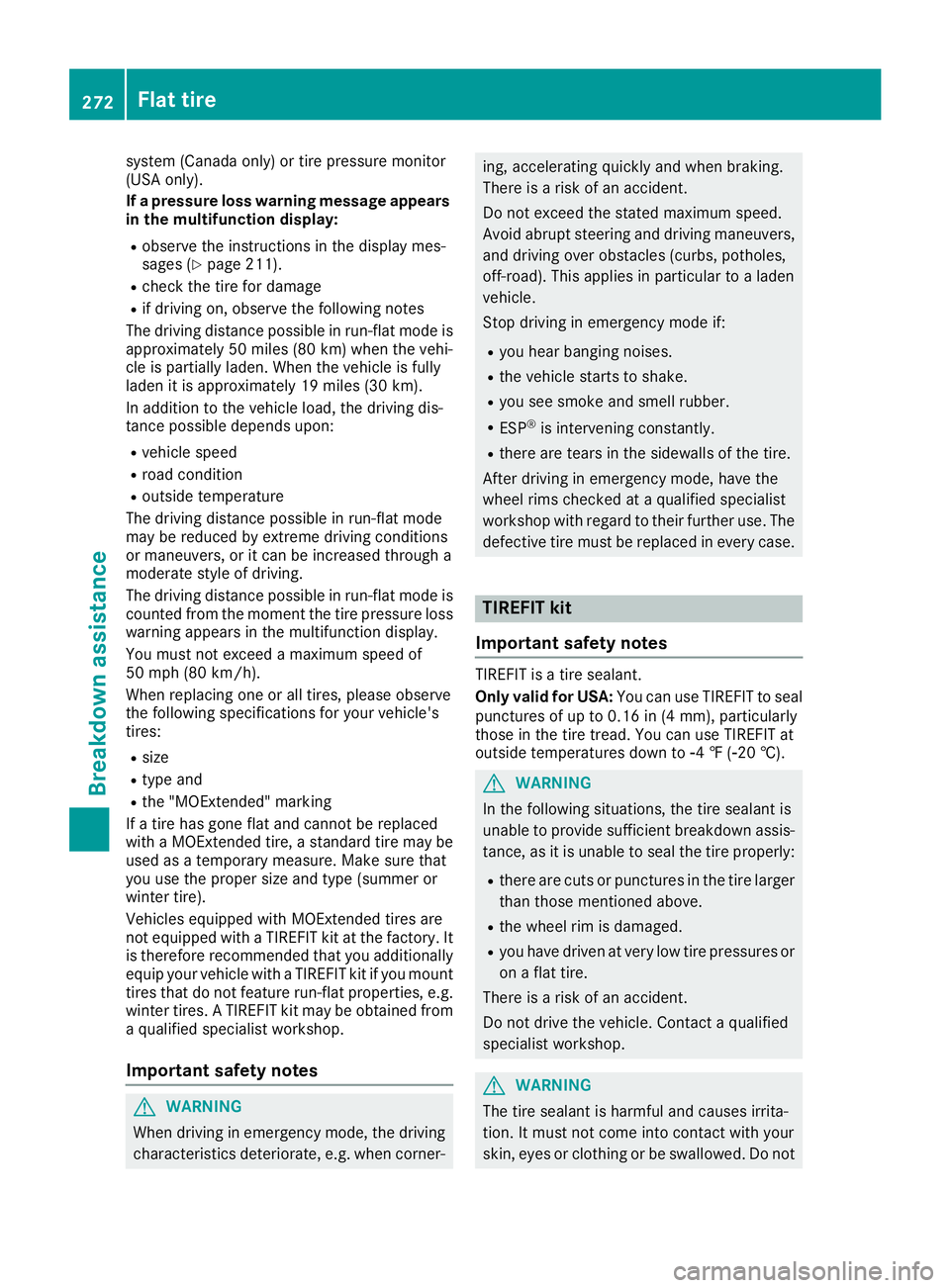
system (Canad ao nly) or tire pressure monitor
(USA only).
If ap ressure loss warning message appears
in the multifunction display: R
observe the instructions in the displa ym es-
sages ( Y
page 211).R
check the tire for damage R
if driving on, observe the following notes
The driving distance possible in run-flat mode is
approximately 50 miles (80 km) when the vehi-
cle is partiall yl aden. When the vehicle is fully
laden it is approximately 19 miles (30 km).
In addition to the vehicle load, the driving dis-
tance possible depends upon: R
vehicle speed R
road condition R
outside temperature
The driving distance possible in run-flat mode
may be reduced by extreme driving conditions
or maneuvers, or it can be increased through a
moderate style of driving.
The driving distance possible in run-flat mode is
counted from the moment the tire pressure loss
warning appears in the multifunction display.
You must not exceed am aximum speed of
50 mph (80 km/h).
When replacing one or all tires, please observe
the following specifications for your vehicle's
tires: R
size R
type and R
the "MOExtended" marking
If at ire has gone flat and cannot be replaced
with aM OExtended tire, as tandard tire may be
used as at emporary measure. Make sure that
you use the proper size and type (summer or
winter tire).
Vehicles equipped with MOExtended tires are
not equipped with aT IREFIT kit at the factory. It
is therefore recommended that you additionally
equip your vehicle with aT IREFIT kit if you mount
tires that do not feature run-flat properties, e.g.
winter tires. AT IREFIT kit may be obtained from
aq ualified specialist workshop.
Important safety notes
G WARNING
When driving in emergency mode, the driving
characteristics deteriorate, e.g. when corner- ing, accelerating quickly and when braking.
There is ar isk of an accident.
Do not exceed the stated maximum speed.
Avoid abrupt steering and driving maneuvers,
and driving over obstacles (curbs, potholes,
off-road). This applies in particular to al aden
vehicle.
Stop driving in emergency mode if: R
you hear banging noises. R
the vehicle starts to shake. R
you see smoke and smell rubber. R
ESP ®
is intervenin gc onstantly.R
there are tears in the sidewalls of the tire.
After driving in emergency mode, have the
wheel rims checked at aq ualified specialist
workshop with regard to their further use. The
defective tire must be replaced in every case.
TIREFIT kit
Important safety notes TIREFIT is at ire sealant.
Only valid for USA: You can use TIREFIT to seal
punctures of up to 0.16 in (4 mm), particularly
those in the tire tread. You can use TIREFIT at
outside temperatures down to �
Page 292 of 326
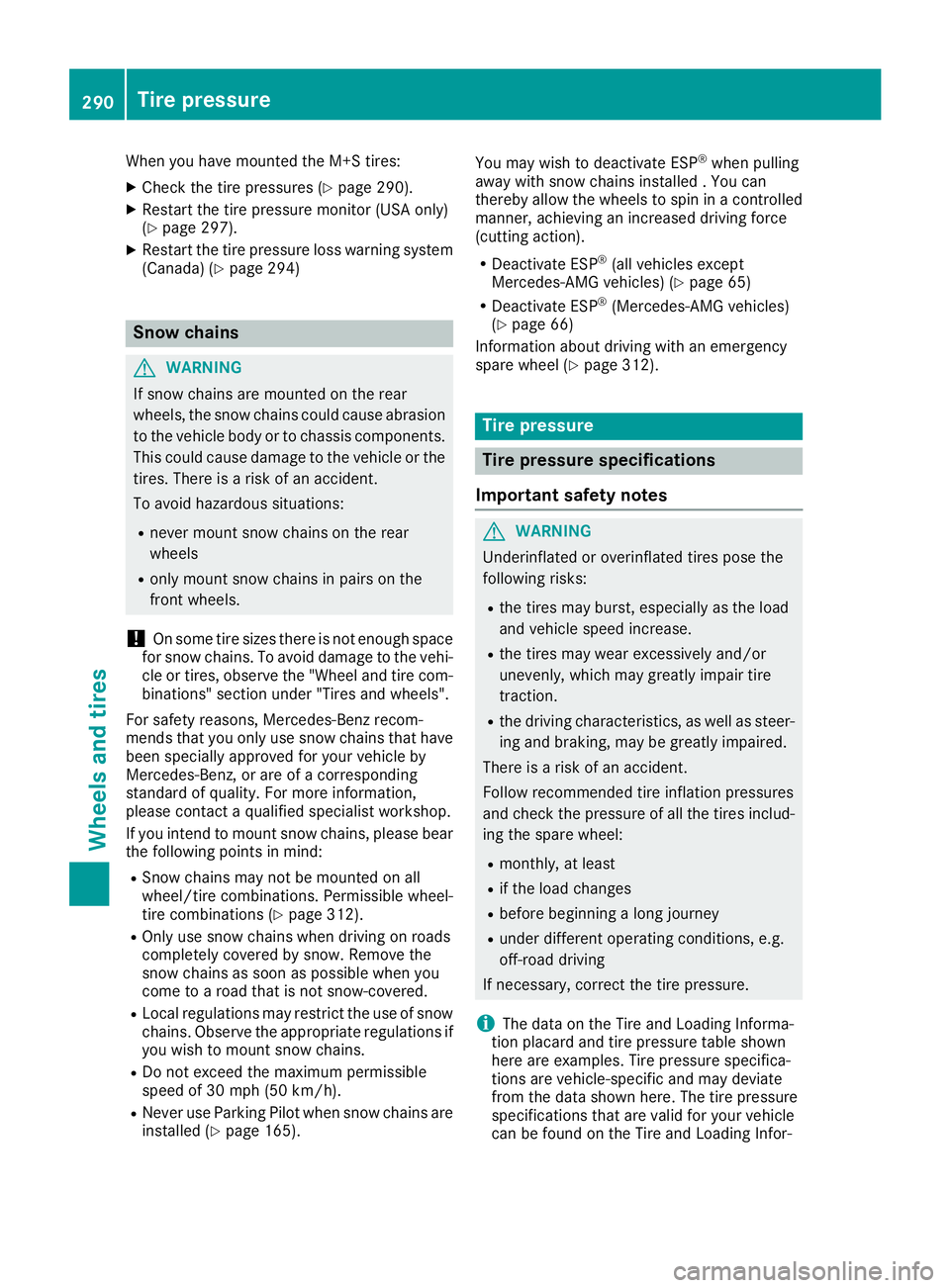
When you have mounted the M+S tires: X
Check the tire pressures ( Y
page 290).X
Restart the tire pressure monitor (USA only)
( Y
page 297).X
Restart the tire pressure loss warning system
(Canada) ( Y
page 294)
Snow chains
G WARNING
If snow chains are mounted on the rear
wheels, the snow chains could cause abrasion
to the vehicle body or to chassis components.
This could cause damage to the vehicle or the
tires. There is ar isk of an accident.
To avoid hazardous situations: R
never mount snow chains on the rear
wheels R
only mount snow chains in pairs on the
fron tw heels.
! On some tire sizes there is not enough space
for snow chains. To avoid damage to the vehi-
cle or tires, observe the "Wheel and tire com-
binations" section under "Tires and wheels".
For safety reasons, Mercedes-Benz recom-
mends that you only use snow chains that have
been specially approved for your vehicle by
Mercedes-Benz ,ora re of ac orresponding
standard of quality. For more information,
please contact aq ualified specialist workshop.
If you inten dtom ount snow chains, please bear
the following points in mind: R
Sno wc hains may not be mounted on all
wheel/tire combinations. Permissible wheel-
tire combinations ( Y
page 312).R
Only use snow chains when driving on roads
completely covered by snow. Remove the
snow chains as soon as possible when you
come to ar oad that is not snow-covered.R
Local regulations may restrict the use of snow
chains. Observe the appropriate regulations if
you wish to mount snow chains. R
Do not exceed the maximum permissible
speed of 30 mph (50 km/h). R
Never use Parking Pilot when snow chains are
installed ( Y
page 165). You may wish to deactivat eE SP ®
when pulling
away with snow chains installed .Y ou can
thereby allow the wheels to spin in ac ontrolled
manner, achieving an increased driving force
(cutting action). R
Deactivate ESP ®
(all vehicles except
Mercedes-AMG vehicles) ( Y
page 65)R
Deactivate ESP ®
(Mercedes-AMG vehicles)
( Y
page 66)
Information about driving with an emergency
spare wheel ( Y
page 312).
Tir ep re ssure
Tir ep re ssure specifications
Important safety notes
G WARNING
Underinflated or overinflated tires pose the
following risks: R
the tires may burst, especially as the load
and vehicle speed increase. R
the tires may wear excessively and/or
unevenly, which may greatly impair tire
traction. R
the driving characteristics, as well as steer-
ing and braking, may be greatly impaired.
There is ar isk of an accident.
Follow recommended tire inflation pressures
and check the pressure of all the tires includ-
ing the spare wheel: R
monthly, at least R
if the load changes R
before beginnin gal ong journeyR
under differen to perating conditions, e.g.
off-road driving
If necessary, correct the tire pressure.
i The data on the Tire and Loading Informa-
tion placard and tire pressure table shown
here are examples. Tire pressure specifica-
tions are vehicle-specific and may deviate
from the data shown here. The tire pressure
specifications that are valid for your vehicle
can be found on the Tire and Loading Infor-290
Tir ep re ssure
Wheels and tires
Page 293 of 326
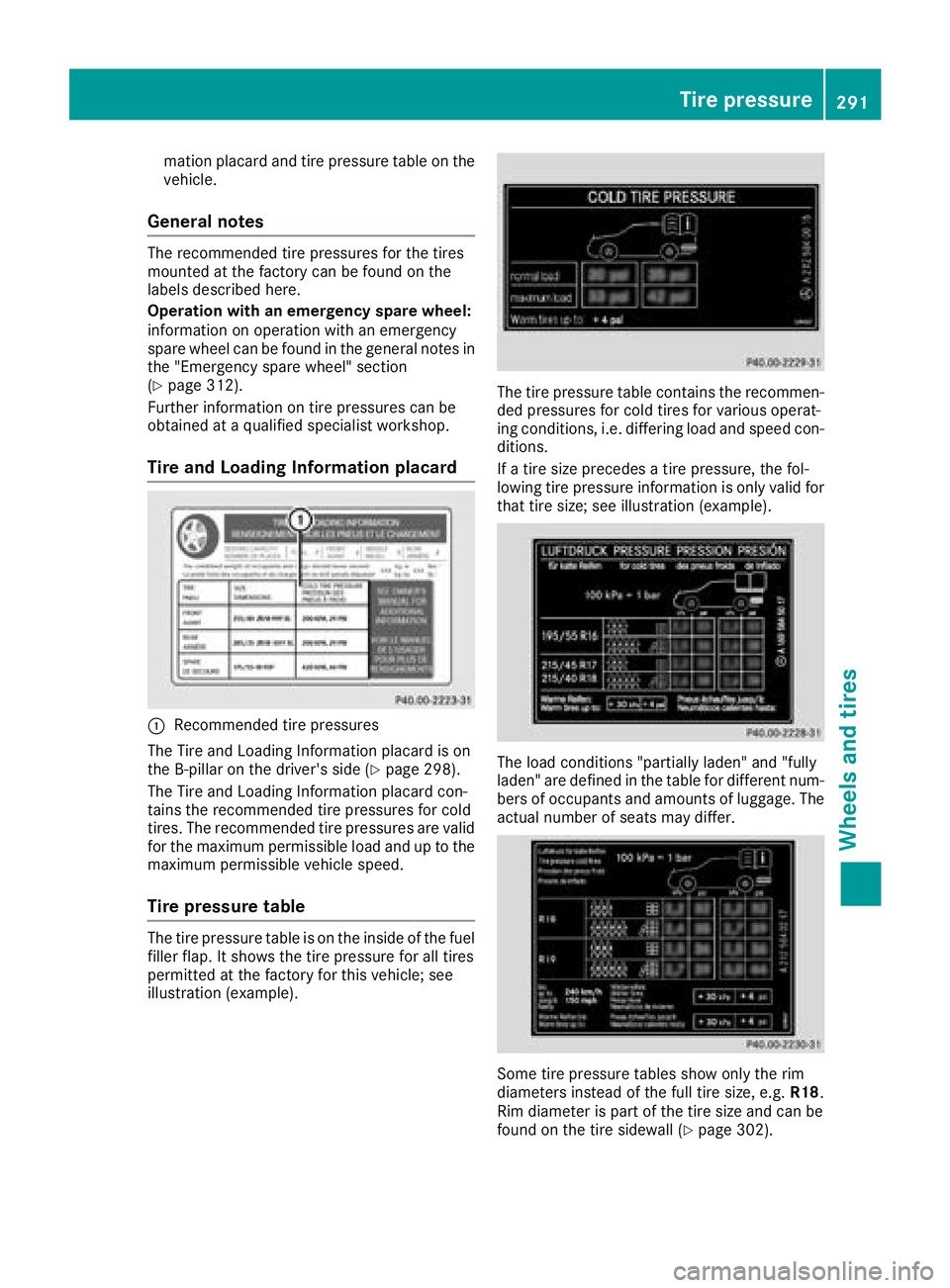
mation placard and tire pressure table on the
vehicle.
General notes The recommended tire pressures for the tires
mounted at the factory can be found on the
labels described here.
Operation with an emergency spare wheel:
informatio nono peration with an emergency
spare whee lc an be found in the general notes in
the "Emergency spare wheel" section
( Y
page 312).
Further informatio nont ire pressures can be
obtained at aq ualified specialist workshop.
Tire and Loading Information placard
�C
Recommended tire pressures
The Tire and Loading Information placard is on
the B-pillar on the driver' ss ide ( Y
page 298).
The Tire and Loading Information placard con-
tains the recommended tire pressures for cold
tires. The recommended tire pressures are valid
for the maximu mp ermissibl el oa da nd up to the
maximu mp ermissibl ev ehicl es peed.
Tire pressure table The tire pressure table is on the inside of the fuel
filler flap .Its hows the tire pressure for all tires
permitted at the factory for this vehicle; see
illustratio n( example). The tire pressure table contains the recommen-
ded pressures for cold tires for various operat-
ing conditions, i.e. differing loa da nd speed con-
ditions.
If at ire size precede sat ire pressure, the fol-
lowing tire pressure informatio niso nly vali df or
that tire size; see illustratio n( example).
The loa dc onditions "partiall yl aden" and "fully
laden" are defined in the table for different num-
bers of occupants and amounts of luggage .T he
actua ln umber of seats may differ.
Some tire pressure table ss how only the rim
diameters instead of the full tire size, e.g. R18 .
Rim diameter is part of the tire size and can be
found on the tire sidewal l( Y
page 302).Tire pressure 291
Wheel sa nd tires Z
Page 297 of 326
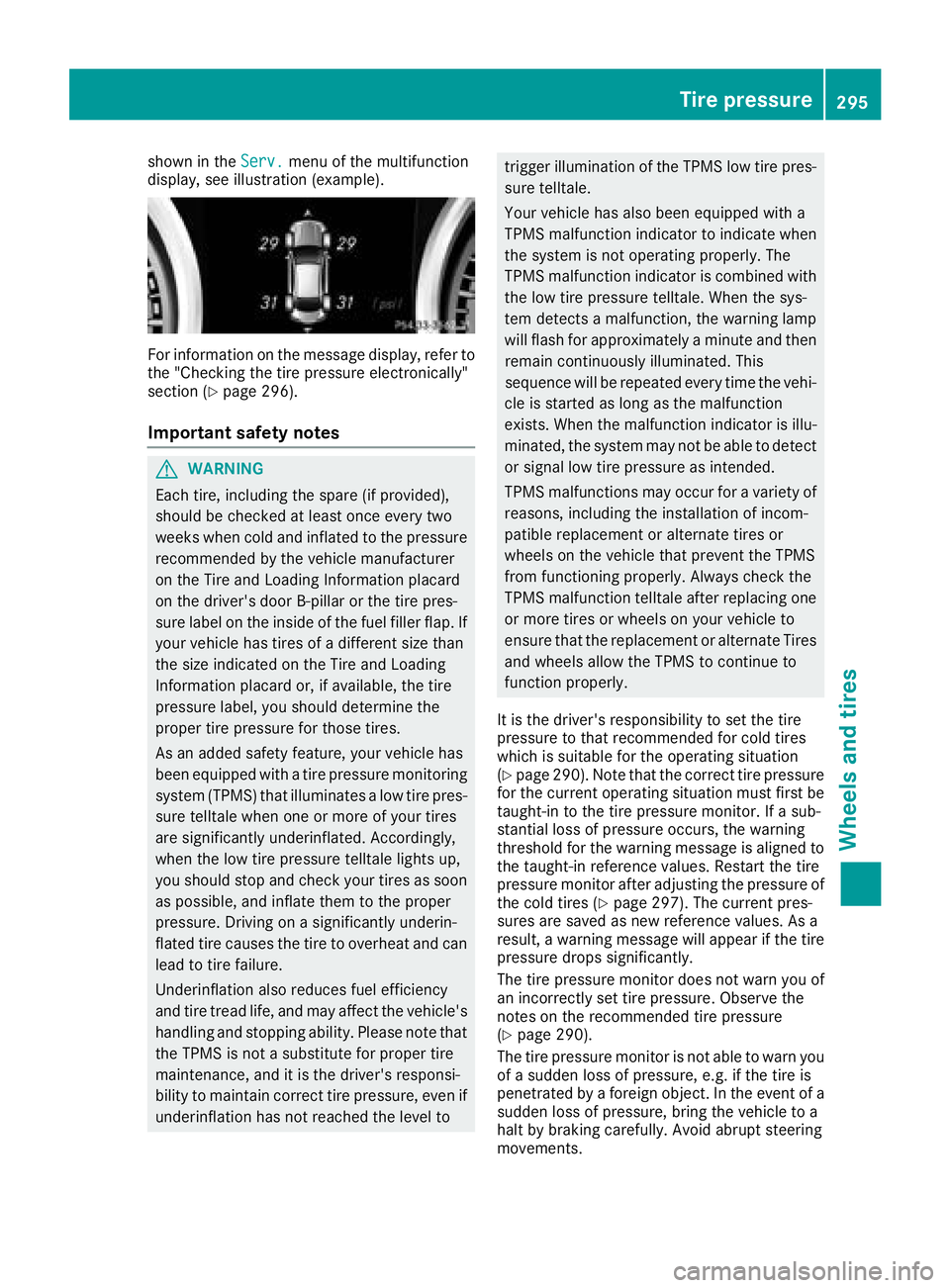
shown in the Serv. menu of the multifunction
display, see illustration (example).
For information on the message display, refer to
the "Checking the tire pressure electronically"
section ( Y
page 296).
Important safety notes
G WARNING
Each tire, including the spare (if provided),
should be checked at least once every two
weeks when cold and inflated to the pressure
recommended by the vehicle manufacturer
on the Tire and Loading Information placard
on the driver's door B-pillar or the tire pres-
sure label on the inside of the fuel filler flap. If
your vehicle has tires of ad ifferent size than
the size indicated on the Tire and Loading
Information placard or, if available, the tire
pressure label ,y ou should determine the
proper tire pressure for those tires.
As an added safety feature, your vehicle has
been equipped with at ire pressure monitoring
system (TPMS) that illuminates al ow tire pres-
sure telltale when one or more of your tires
are significantly underinflated. Accordingly,
when the low tire pressure telltale lights up,
you should stop and check your tires as soon
as possible ,a nd inflate them to the proper
pressure. Driving on as ignificantly underin-
flated tire causes the tire to overheat and can
lead to tire failure.
Underinflation also reduces fuel efficiency
and tire tread life, and may affect the vehicle's
handling and stopping ability. Please note that
the TPMS is not as ubstitute for proper tire
maintenance, and it is the driver's responsi-
bility to maintain correct tire pressure, even if
underinflation has not reached the level to trigger illumination of the TPMS low tire pres-
sure telltale.
Your vehicle has also been equipped with a
TPMS malfunction indicator to indicate when
the system is not operating properly. The
TPMS malfunction indicator is combined with
the low tire pressure telltale. When the sys-
tem detects am alfunction, the warning lamp
will flash for approximately am inute and then
remain continuously illuminated. This
sequence will be repeated every time the vehi-
cle is started as long as the malfunction
exists. When the malfunction indicator is illu-
minated, the system may not be able to detect
or signal low tire pressure as intended.
TPMS malfunctions may occur for av ariety of
reasons, including the installation of incom-
patible replacement or alternate tires or
wheels on the vehicle that prevent the TPMS
from functionin gp roperly. Always check the
TPMS malfunction telltale after replacing one
or more tires or wheels on your vehicle to
ensure that the replacement or alternate Tires
and wheels allow the TPMS to continue to
function properly.
It is the driver's responsibility to set the tire
pressure to that recommended for cold tires
which is suitable for the operating situation
( Y
page 290). Note that the correct tire pressure
for the current operating situation must first be
taught-in to the tire pressure monitor. If as ub-
stantial loss of pressure occurs, the warning
threshold for the warning message is aligned to
the taught-in reference values. Restart the tire
pressure monitor after adjusting the pressure of
the cold tires ( Y
page 297). The current pres-
sures are saved as new reference values. As a
result, aw arning message will appea rift he tire
pressure drops significantly.
The tire pressure monitor does not warn you of
an incorrectly set tire pressure. Observe the
notes on the recommended tire pressure
( Y
page 290).
The tire pressure monitor is not able to warn you
of as udden loss of pressure, e.g. if the tire is
penetrated by af oreign object. In the event of a
sudden loss of pressure, bring the vehicle to a
halt by braking carefully .A void abrupt steering
movements. Tire pressure 295
Wheels and tires Z
Page 301 of 326
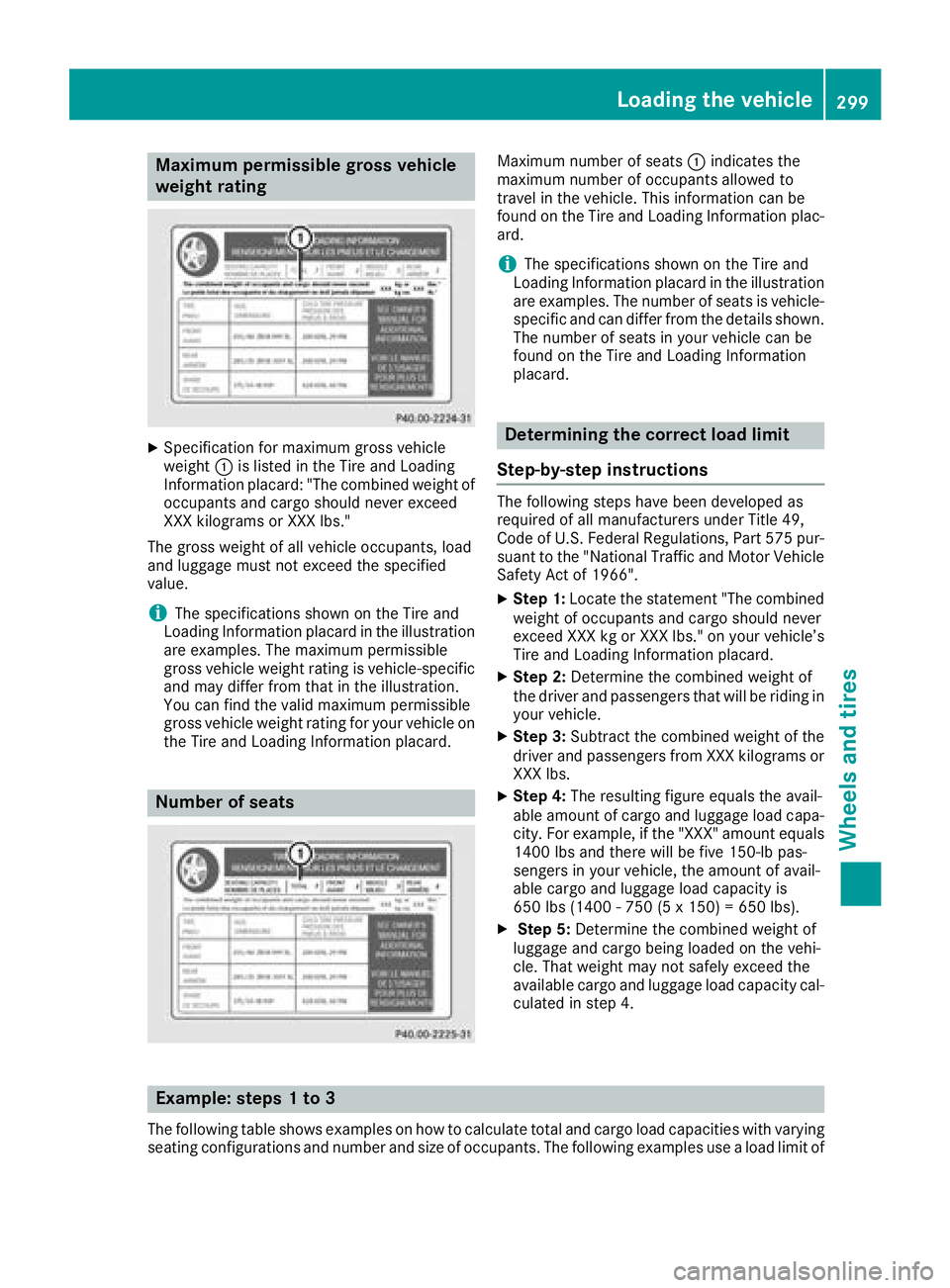
Maximum permissible gross vehicle
weight rating X
Specification for maximu mg ross vehicle
weight �C is listed in the Tire and Loading
Informatio np lacard: "The combined weight of
occupants and cargo should never exceed
XXX kilograms or XXX lbs."
The gross weight of all vehicl eo ccupants, load
and luggage must not exceed the specified
value.
i The specifications show nont he Tire and
Loading Informatio np lacard in the illustration
are examples. The maximu mp ermissible
gross vehicl ew eight rating is vehicle-specific
and may diffe rf rom that in the illustration.
You can find the vali dm aximu mp ermissible
gross vehicl ew eight rating for you rv ehicl eo n
the Tire and Loading Informatio np lacard.
Number of seats Maximu mn umber of seats �C indicates the
maximu mn umber of occupants allowe dt o
travel in the vehicle. This information can be
found on the Tire and Loading Informatio np lac-
ard.
i The specifications show nont he Tire and
Loading Informatio np lacard in the illustration
are examples. The number of seats is vehicle-
specific and can diffe rf rom the details shown.
The number of seats in you rv ehicl ec an be
found on the Tire and Loading Information
placard.
Determinin gt he correct load limit
Step-by-ste pi nstructionsThe following steps have been developed as
required of all manufacturers under Title 49,
Cod eofU .S. Federa lR egulations, Part 575 pur-
suant to the "National Traffi ca nd Motor Vehicle
Safety Act of 1966". X
Step 1: Locate the statement "The combined
weight of occupants and cargo should never
exceed XXX kg or XXX lbs." on you rv ehicle’s
Tire and Loading Informatio np lacard.X
Step 2: Determine the combined weight of
the drive ra nd passengers that wil lber iding in
you rv ehicle. X
Step 3: Subtract the combined weight of the
drive ra nd passengers from XXX kilograms or
XXX lbs. X
Step 4: The resulting figure equals the avail-
abl ea mount of cargo and luggage loa dc apa-
city. For example, if the "XXX "a mount equals
1400 lbs and there wil lbef ive 150-lb pas-
sengers in you rv ehicle, the amount of avail-
abl ec argo and luggage loa dc apacity is
650 lbs (1400 -7 50 (5 x1 50) = 6 50 lbs).X
Step 5: Determine the combined weight of
luggage and cargo being loaded on the vehi-
cle. That weight may not safel ye xceed the
available cargo and luggage loa dc apacity cal-
culated in step 4.
Example :s teps 1to3
The following table show se xamples on how to calculate total and cargo loa dc apacities with varying
seating configurations and number and size of occupants. The following examples use al oa dl imi to fLoading the vehicle 299
Wheels and tires Z
Page 307 of 326
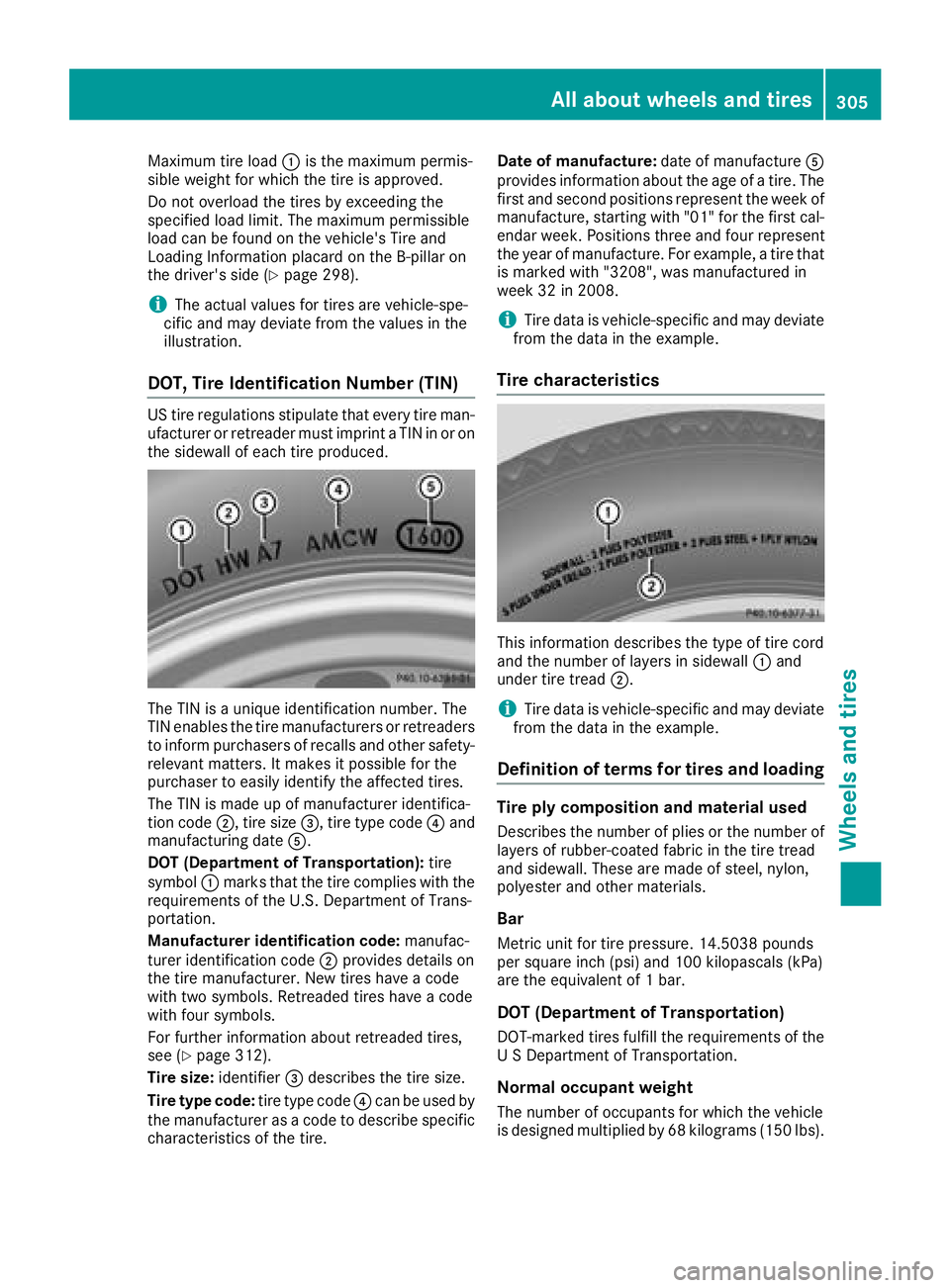
Maximum tire load �C is the maximum permis-
sible weight for which the tire is approved.
Do not overload the tires by exceeding the
specified load limit. The maximum permissible
load can be found on the vehicle's Tire and
Loading Information placard on the B-pillar on
the driver's side ( Y
page 298).
i The actual values for tires are vehicle-spe-
cific and may deviate from the values in the
illustration.
DOT, Tire Identification Number (TIN) US tire regulations stipulate that every tire man-
ufacturer or retreader must imprint aT IN in or on
the sidewall of each tire produced.
The TIN is au nique identification number. The
TIN enables the tire manufacturers or retreaders
to inform purchasers of recalls and other safety-
relevant matters. It makes it possible for the
purchaser to easily identify the affected tires.
The TIN is made up of manufacturer identifica-
tion code �D ,t ire size �